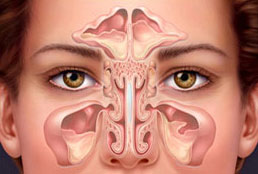
Where are the sinuses located ?
Sinuses are air-filled cavities on both sides of the nose, extending backwards, and the forehead.
What is sinusitis ?
Sinusitis is an inflammatory disease of the sinuses.
How do we get sinusitis ?
Sinusitis usually occurs following a viral upper respiratory tract infection such as common cold, with the obstruction of the openings of sinuses to the nose. Afterwards, reproduction of microbes occurs.
What are the other reasons of sinusitis ?
The most common form of sinusitis is explained above. Nasal septum deviation, concha bullosa, some anatomical variations that narrow the sinus openings, hay fever, polyps, some dental infections, and adenoid problems in children may lead to sinusitis. Nasal packings, diving, tumors, foreign bodies, traumas, immune system diseases or immunosuppressive treatments may predispose to sinusitis.
What are the symptoms of sinusitis ?
The most important symptoms of sinusitis are runny nose and nasal obstruction. In addition, facial pain and headache, facial pressure and feeling of fullness, smell disorder, toothache, bad breath, fever, cough, fatigue, ear pain and fullness in the ear, are making part of the symptoms of sinusitis.
How to diagnose sinusitis ?
The diagnosis of sinusitis is a clinical diagnosis. First, the symptoms are noted, then an examination is made including endoscopic examination.
Is radiological evaluation necessary for the diagnosis ?
In most of the cases, radiological exam is not required. Since plain X-ray films, could be misinterpreted, CT (computed tomography) is mostly used today when a radiological examination is to be performed. Rarely, an MRI (magnetic resonance imaging) is done additionnally.
When a CT scan is done ?
CT is done when medical treatment fails and a surgery is scheduled. In addition, in some cases with diagnostic confusion, for example, in cases with chronic headache, CT may reveal whether the headache in question is due to sinusitis.
Is sinusitis a chronic disease ?
Many people believe that sinusitis is a chronic disease. However, chronic sinusitis can be mentioned when sinusitis-related complaints and examination findings are over 3 months. Contrary to popular belief, most sinusitis are not chronic.
What is the treatment of sinusitis ?
The primary treatment of sinusitis is medical therapy. 10-14 days of antibiotic treatment is administered. This period can be kept longer in chronic sinusitis. In addition to antibiotics, other drugs including decongestants, pain killers, and nasal rinsing can be used. Surgery is performed when medical treatment fails.

How is sinus surgery performed ?
Sinus surgery is commonly made using endoscopes, without making any external incision, so called endoscopic sinus surgery. The basic principle here is to remove the diseased tissues, and polyps if any, and to open the ostia of the sinuses, so that the sinuses can be ventilated well. In the same session, nasal septum deviation can be fixed, and turbinates can be reduced if necessary.
Is endoscopic sinus surgery performed under general anesthesia ?
Although endoscopic sinus surgery can be performed with local anesthesia under sedation, like many surgeons, I prefer general anesthesia.
What are the complications of endoscopic sinus surgery ?
Complications of endoscopic sinus surgery include bleeding, infection, loss of smell, intranasal adhesions, and very rarely nasal cerebrospinal fluid leakage, meningitis, brain abscess, blindness, double vision and heavy bleeding due to carotid artery damage.
How is the post-surgery course ?
An absorbable packing is used after the surgery. Some medications including antibiotics, cortisone nasal sprays, nasal decongestant nasal sprays, nasal rinsing might be used as recommended by your physician. Crusting may occur in the nose. The patient should be seen by the physician once a week for 3-4 weeks to clean them up.
What is the treatment for polyps ?
Currently, two main treatments are used in the treatment of polyps: medical therapy and surgical treatment. The basis of medical therapy is cortisone therapy. Cortisone suppresses the inflammatory response, shrinks polyps and suppresses their recurrence after surgery. When the polyps are reduced with medical treatment, a CT is done. With endoscopic sinus surgery, polyps are removed and the openings of the sınuses are opened. Then, cortisone sprays, some medications, and nasal rinsing are used in order to prevent any recurrence.
Do polyps recur ?
By nature, polyps are prone to recur. The objective of surgery is to create a well-aerated cavity which enable cortisone sprays to penetrate in.


